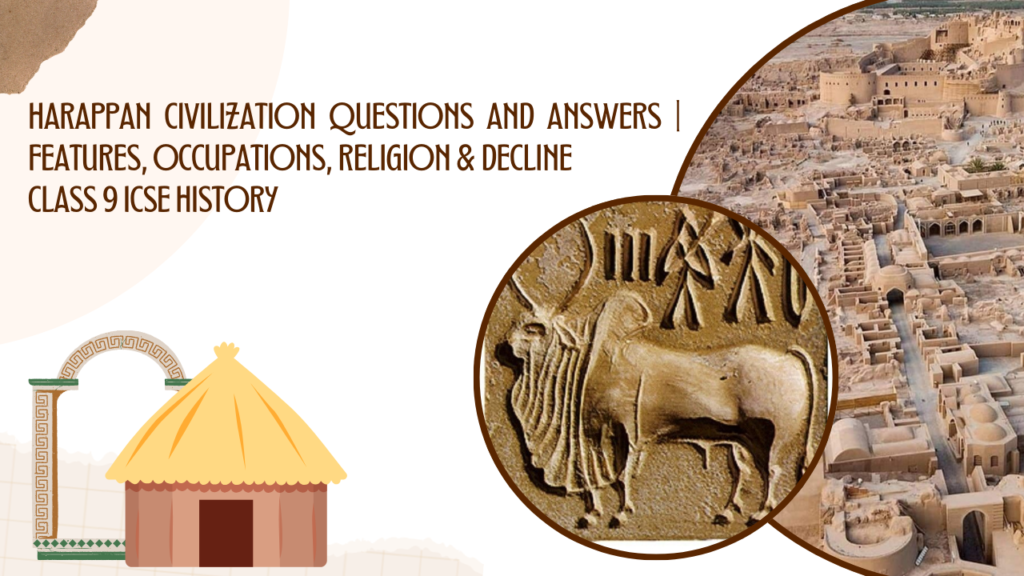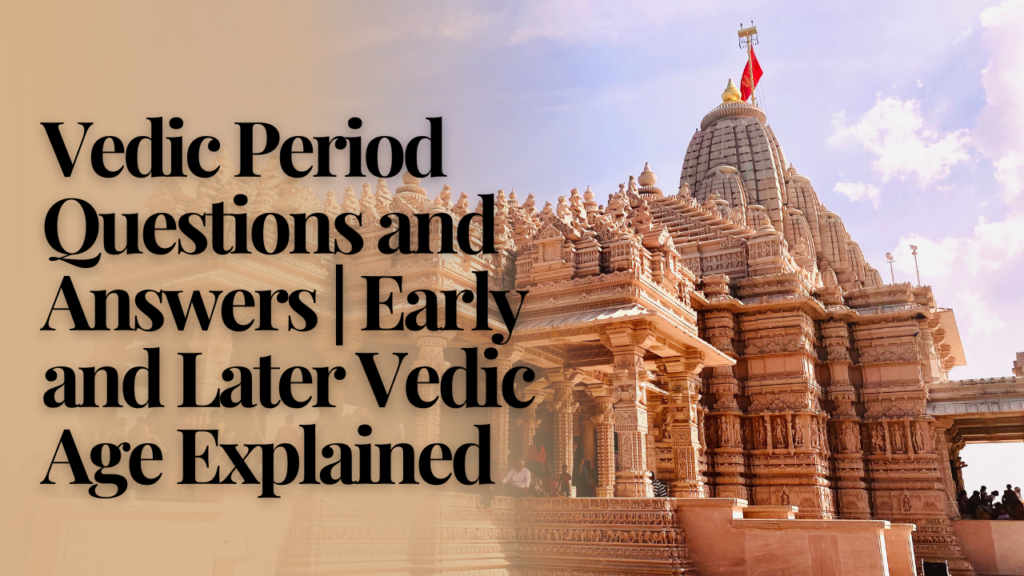Mauryan Empire and Ashoka – Rise, Kalinga War, Dhamma, and Administration Explained
Short Question Answers Set I
Question 1: Who succeeded Bindusara and when?
Ans: Bindusara was succeeded by Emperor Ashoka in 219 BC, marking an important phase in the Mauryan Empire.
Question 2: Discuss the sources that help us to know about Ashoka’s reign.
Ans: Much of our knowledge about the history of Ashoka’s reign in the Mauryan Empire is based on Ashokan inscriptions engraved on rocks and pillars. These Mauryan edicts provide information about his policies and administration but do not shed light on his early life.
Question 3: Why do historians believe that Ashoka’s ascension to the throne was not a smooth affair?
Ans: According to some literary sources, Ashoka ascended the throne by eliminating rivals, including his 99 brothers. While this may be exaggerated, historians agree that Ashoka’s rise to power in the Mauryan dynasty was not a peaceful transition.
Question 4: When was the Kalinga War fought?
Ans: The Kalinga War, a significant event in Mauryan history, was fought in 211 BC.
Question 5: What factors prompted Ashoka to conquer Kalinga?
Ans: The conquest of Kalinga in 261 BC was prompted by several factors:
- Kalinga had asserted its independence after the fall of the Nanda dynasty.
- Its military strength posed a challenge to the Mauryan Empire.
Short Question Answers Set II
Question 6: Why is the Kalinga War regarded as a turning point in Ashoka’s life?
Ans: The Kalinga War was a turning point in Ashoka’s life. The bloodshed and destruction filled the Mauryan emperor with remorse. Although further conquests, like the Tamil states, could have expanded the Mauryan Empire, Ashoka abandoned military expansion. Buddhism and Ashoka Dhamma then became central to his reign, as he focused on peace and ethical governance.
Question 7: What was the impact of the Kalinga War?
Ans: The impact of the Kalinga War on the Mauryan Empire was profound. The large-scale loss of life and property shocked Ashoka, leading him to renounce violence. This marked the beginning of Ashoka’s Dhamma policies and a focus on moral governance and welfare.
Question 8: What did Ashoka replace Digvijay with?
Ans: Ashoka replaced Digvijaya (world conquest) with Dhammavijaya, conquest through Ashoka Dhamma, reflecting the shift from military expansion to moral and ethical leadership in the Mauryan Empire.
Question 9: What do you understand by Ashoka’s Dhamma?
Ans: Dhamma, synonymous with Dharma, signified virtue, morality, law, and duty. It was a code of conduct followed during the Mauryan period, guiding the emperor’s governance and welfare policies.
Question 10: What are the tenets of Dhamma?
Ans: The tenets of Ashoka Dhamma include:
- Obeying elders
- Being kind to all, including servants and slaves
- Respecting other religions
- Following ahimsa (non-violence)
- Salvation through morality and kindness
Short Question Answers Set III
Question 11: What steps did Ashoka take to spread Dhamma?
Ans: Ashoka took several steps to spread Dhamma:
- Created a class of officers called Dhamma Mahamattas to ensure public welfare.
- Undertook Dhammayatra, royal tours to preach moral policies.
- Sent missionaries, including his children Mahendra and Sanghamitra, to Ceylon, helping to spread Buddhism internationally.
Question 12: How did Dhamma influence the art of the Mauryan period?
Ans: Ashoka Dhamma influenced Mauryan art and architecture. Tall polished pillars crowned with animals, such as the Sarnath Pillar, Bhopal Pillar, and Lauriya Nanadangarh Pillar, became symbols of moral authority and spiritual guidance.
Question 13: What prompted Ashoka to promote welfare measures?
Ans: Influenced by Ashoka Dhamma, the emperor adopted a paternal attitude towards his subjects. His edicts show that he wanted the welfare and happiness of all people, reflecting the importance of Mauryan welfare measures.
Question 14: Enumerate the welfare measures adopted by Ashoka.
Ans: Ashoka implemented several Mauryan welfare measures:
- Built roads, wells, and rest houses
- Planted trees like banyan and mango for the benefit of men and animals
- Imported and planted medicinal plants
- Ensured the happiness and welfare of his people
Question 15: Who was the last Mauryan ruler?
Ans: The last Mauryan emperor was Brihadratha, killed by Pushyamitra Sunga in 185 BC.
Short Question Answers Set IV
Question 16: Discuss the sources that tell us about the Mauryan administration.
Ans: The Mauryan administration is documented in Megasthenes’s Indica and Kautilya’s Arthashastra, which describe governance, taxation, law, and bureaucracy.
Question 17: Under what heads can the Mauryan administration be studied?
Ans: The Mauryan administration can be studied under: central, provincial, district, and village administration.
Question 18: Which Mauryan king never kept his petitioners waiting? Why?
Ans: Chandragupta Maurya, the founder of the Mauryan Empire, never kept petitioners waiting, reflecting efficient governance and administrative discipline.
Question 19: Discuss the officers who assisted the king in administering the empire.
Ans: The king was assisted by the Mantri Parishad (Council of Ministers), who helped implement policies across the Mauryan Empire.
Question 20: Who were the Pulisani and the Prativedakas?
Ans: Pulisani reported public opinion to the emperor, while Prativedakas acted as special reporters, enhancing the efficiency of the Mauryan administration.
Short Question Answers Set V
Question 21: What was the unique feature of the Mauryan administration?
Ans: The espionage system was unique to the Mauryan administration, with spies appointed from among loyal citizens to maintain security.
Question 22: Into how many provinces was the Mauryan Empire divided?
Ans: The Mauryan Empire was divided into four provinces with capitals: Taxila (North), Ujjain (West), Tosali (East), and Suvarnagiri (South).
Question 23: Who looked after the provincial administration?
Ans: Provincial administration was managed by a Kumara or Aryaputra, ensuring effective governance throughout the Mauryan Empire.
Question 24: Who were Pradeshika, Rajuka, and Yuktas?
Ans:
- Pradeshika: Officers in charge of overall administration
- Rajuka: Managed law, order, and revenue collection
- Yuktas: Subordinate officers responsible for records
Question 25: Who was Gopa? What was his function?
Ans: Gopa was a village official responsible for maintaining population consensus and local administration, reflecting the efficiency of Mauryan local governance.
Long Question Answers
The early life of Ashoka is a study in contrast to his later life. To show the difference, throw light on:
a: His early conquests:
- The Kalinga War in 211 BC marked Ashoka’s military ambitions.
- Kalinga’s prior independence under the Nandas and its strong military prompted the conquest.
b: His welfare measures:
- Ashoka focused on Mauryan welfare measures, building roads, wells, rest houses, and planting trees and medicinal plants.
c: Ashoka and Dhamma:
- Replaced Digvijaya with Dhammavijaya, promoting conquest through Ashoka Dhamma.
- Tenets of Dhamma: obey elders, kindness to all, respect other religions, follow ahimsa, and achieve salvation through morality.


